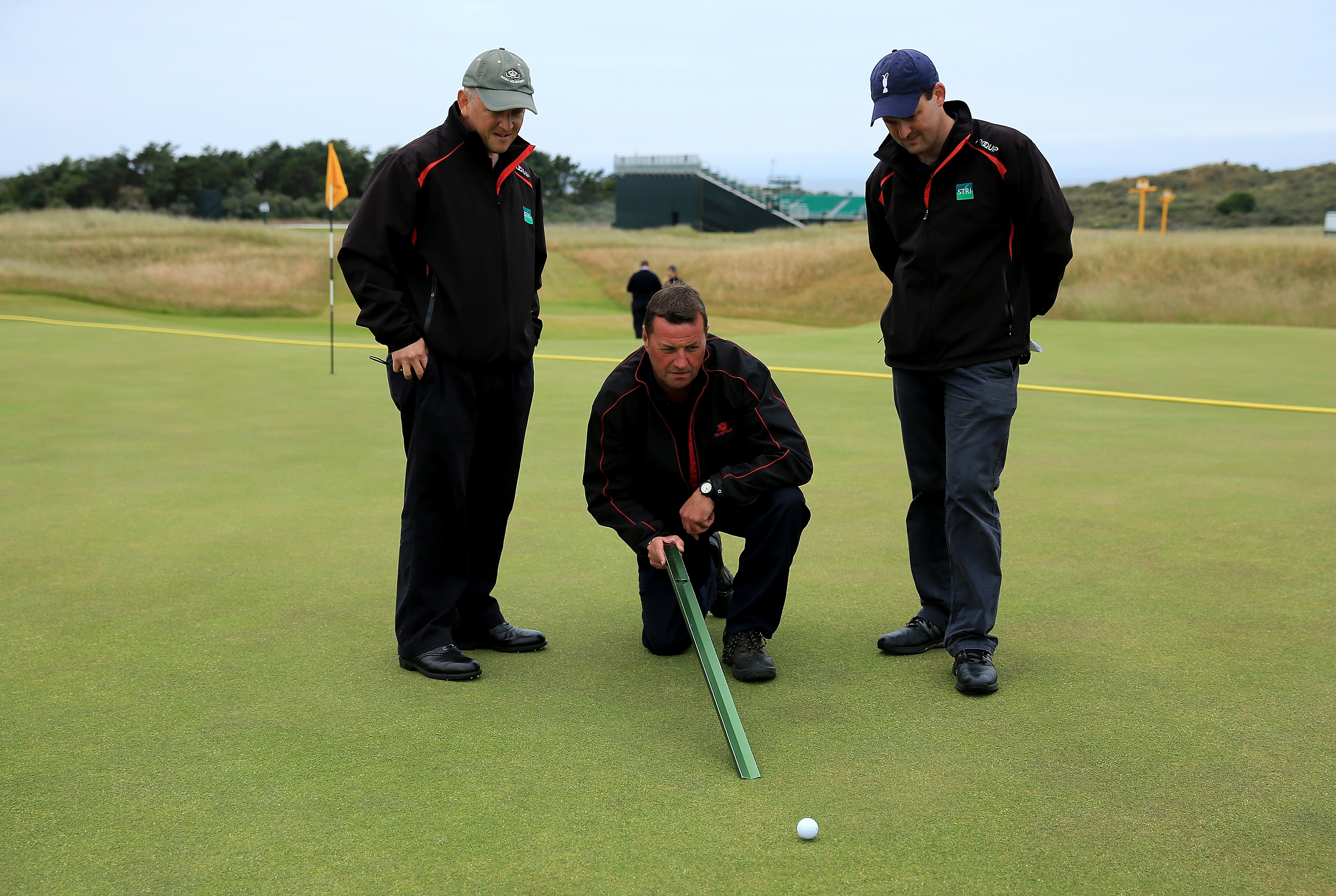What Is A Stimpmeter And How Does It Work?
If we told you it measures speed, you'd probably be able to guess exactly what this simple device was


Fergus Bisset
It’s rare for this device not to get a mention during television coverage of the golf, especially when the topic is the speed of the greens.
The stimpmeter, which is often shortened to ‘stimp’, is a crucial tool for greenkeepers and course managers. It’s a device that is used to measure the speed of greens, hence why we hear it mentioned a lot when players are lining up putts, especially at Augusta National, where the surfaces are famous for being very quick.
How does a stimpmeter work?
The stimpmeter measures 36 inches (91cm) in length and has a V-shaped chute down which a golf ball can roll. It is designed with two notches in it on which can rest a ball. One of these notches is 30 inches from the tapered end that rests on the ground, and the other is 14 inches from the end.
To measure the speed of the greens, a flat area will be selected. A golf ball is placed on the notch which is 30 inches from the end – also known as the 1X notch – and that end of the stimpmeter is lifted slowly, with the other end still resting on the green, until the ball rolls down the chute and across the green.
A measurement is then taken from the end of the stimpmeter to the ball’s finishing position. This process is repeated three times and, so long as each reading is within eight inches of one another, the average of these three becomes one of the two measurements that will be used.

Then the process is repeated but with the start point now being the average point of where the three balls finished and the chute is pointed to roll the ball back in the exact opposite direction to the three previous rolls. This means that any slight slopes, or the effect of the grain, will be balanced out.
If the three readings are not within eight inches of each other, the process must be repeated. If the trio still fail to accord with one another, it may be that that section of the green has too much slope.
Get the Golf Monthly Newsletter
Subscribe to the Golf Monthly newsletter to stay up to date with all the latest tour news, equipment news, reviews, head-to-heads and buyer’s guides from our team of experienced experts.
There will be times when it’s not possible to find a suitable area of flat green, in which case it might be necessary to use the other notch, 14 inches up the stimpmeter – the 2X position – so that the ball doesn’t roll as far. In this case, when you have determined the average of the three rolls, this average is then doubled.
The average roll going in one direction is then added to the average roll in the opposite direction; the total is then divided by two. We now have our final figure, which is measured in feet. This is the stimpmeter reading, or ‘stimp reading’.
Why is it called a Stimpmeter?
The device takes its name from its inventor, Edward S. Stimpson. In the 1930s, Stimpson created a wooden version which was, in effect, simply a chute for which a ball to roll down. Modern stimpmeters are made of aluminium.
What is an average stimpmeter reading?
Greenkeepers and course managers will aim to have greens running at a consistent speed across the entire course. If the greens at your golf club are running at around nine or 10, that would be considered average. Of course, this number might increase for the Club Championships or at certain times of the year when faster greens are more desirable because of the challenge they pose.
What is a fast stimpmeter reading?

Tour professionals are more used to putting on surfaces where the stimpmeter readings reach around 13 – and sometimes higher. There is a limit to how fast course managers will want the greens to play. Imagine an exposed links course on a windy day. In conditions like this, you could see the balls moving on the green – and play would most likely have to be suspended.
Contributing Writer Roderick is the author of the critically acclaimed comic golf novel, Summer At Tangents. Golf courses and travel are Roderick’s particular interests. He writes travel articles and general features for the magazine, travel supplement and website. He also compiles the magazine's crossword. He is a member of Trevose Golf & Country Club and has played golf in around two dozen countries. Cricket is his other main sporting love. He is also the author of five non-fiction books, four of which are still in print: The Novel Life of PG Wodehouse; The Don: Beyond Boundaries; Wally Hammond: Gentleman & Player and England’s Greatest Post-War All Rounder.
- Fergus BissetContributing Editor
-
 How To Watch The Chevron Championship 2025: Live Streams, TV Channels, Schedule
How To Watch The Chevron Championship 2025: Live Streams, TV Channels, ScheduleAll the details on how to watch Chevron Championship online and on TV from anywhere, as the first women's Major of 2025 takes place at Carlton Woods this week.
By Roderick Easdale
-
 ‘I Spoke To Two Presidents The Day After’ – Rory McIlroy Reflects On 'Absolutely Amazing' Reaction To Masters Win
‘I Spoke To Two Presidents The Day After’ – Rory McIlroy Reflects On 'Absolutely Amazing' Reaction To Masters WinThe five-time Major winner revealed he had spoken to two presidents in the aftermath of completing the career Grand Slam at The Masters
By Mike Hall
-
 Tiger Woods Didn't Break Par In A Single Major Round This Year... Where Does He Go From Here?
Tiger Woods Didn't Break Par In A Single Major Round This Year... Where Does He Go From Here?Tiger Woods' Major record for 2024 doesn't make for good reading, and as a big Tiger-fan, I worry about what comes next for this legend of the game...
By Barry Plummer
-
 The Open and Dan Brown Show Why Limited-Field Golf Tournaments Should Be Abolished
The Open and Dan Brown Show Why Limited-Field Golf Tournaments Should Be AbolishedDan Brown led the Open Championship after the first round at Royal Troon and a number of other ‘lesser lights’ are in contention. They add so much to golf tournaments
By Nick Bonfield
-
 The Surprising PGA Tour Pro Outdriving LIV Golf's Bryson DeChambeau At The Open
The Surprising PGA Tour Pro Outdriving LIV Golf's Bryson DeChambeau At The OpenHitting the golf ball a long way is Bryson DeChambeau's thing, but one player outperformed him in the driving distance category during round one of the Open...
By Barry Plummer
-
 Is There Still Hope For Bryson DeChambeau At The Open?
Is There Still Hope For Bryson DeChambeau At The Open?Bryson DeChambeau had a challenging day at the Open Championship, but some of these interesting stats suggest it might not be over for the US Open Champion...
By Barry Plummer
-
 This Revealing Stat Shows What Rory McIlroy Must Improve In Major Championship Golf
This Revealing Stat Shows What Rory McIlroy Must Improve In Major Championship GolfRory McIlroy got off to an inauspicious start in tough conditions at the 152nd Open Championship at Royal Troon. Looking at the data, that’s perhaps not a surprise…
By Nick Bonfield
-
 I'm Convinced Justin Thomas Will Win The Open
I'm Convinced Justin Thomas Will Win The OpenAfter a solid opening round, I am completely sold that Justin Thomas can win a third Major Championship title at Royal Troon. Here are three reasons why...
By Barry Plummer
-
 Why Is The Open Winner Called Champion Golfer Of The Year?
Why Is The Open Winner Called Champion Golfer Of The Year?Champion Golfer of The Year is a term you will hear a lot over the course of the next few days, but where exactly did it come from and why is it used?
By Barry Plummer
-
 This Fascinating Scorecard Trend Could Reveal What It Takes To Win The Open Championship...
This Fascinating Scorecard Trend Could Reveal What It Takes To Win The Open Championship...After looking back through the scorecards of previous Open Championship winners, I discovered an interesting trend that could highlight the route to victory
By Barry Plummer